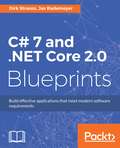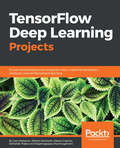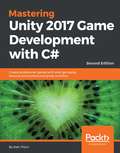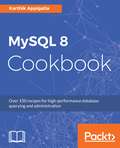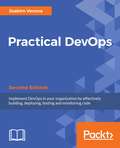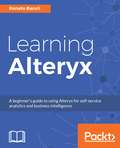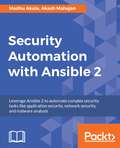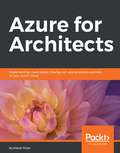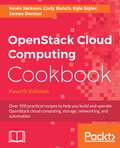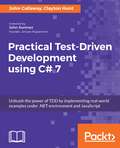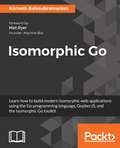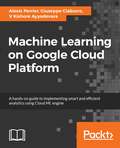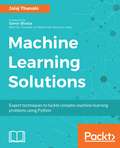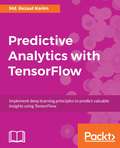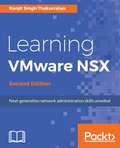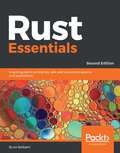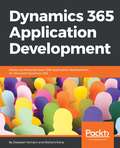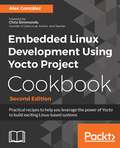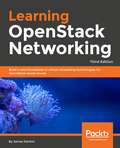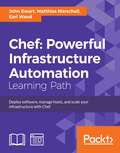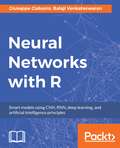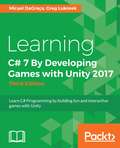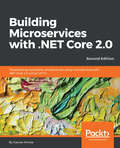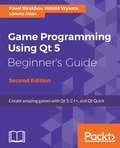- Table View
- List View
C# 7 and .NET Core 2.0 Blueprints: Build effective applications that meet modern software requirements
by Dirk Strauss Jas RademeyerLeverage the features of C# 7 and .NET core 2.0 to build real-world .NET core applicationsKey Features See how to incorporate Entity Framework Core to build ASP .NET core MVC application Get hands-on SignalR and NuGet packages Work with Reactive Extensions (Rx.Net) using the elasticsearch tool Get hands-on with .NET Core MVC, Middleware, Controllers, Views, Layouts, Routing, and authentication Implement Azure Service Fabric and Microservices and AWS, S3,Serverless computing Work on .NET Core cross-platform functionality Run a .NET Core MVC application with Docker compose Easy-to-follow real-world projects that get you up and running with the new features of C# 7 and .NET Core 2.0 The practical applications will assist you with concepts such as Entity Framework Core, serverless computing, microservices, and more in .NET Core 2.0 Explore the workings of Rx.Net and build cross-platform mobile applications using XamarinBook DescriptionNET Core is a general purpose, modular, cross-platform, and open source implementation of .NET. With the latest release of .NET Core, many more APIs are expected to show up, which will make APIs consistent across .Net Framework, .NET Core, and Xamarin. This step-by-step guide will teach you the essential .NET Core and C# concepts with the help of real-world projects.The book starts with a brief introduction to the latest features of C# 7 and .NET Core 2.0 before moving on to explain how C# 7 can be implemented using the object-oriented paradigm. You'll learn to work with relational data using Entity Framework and see how to use ASP.NET Core practically. This book will show you how .NET Core allows the creations of cross-platform applications.You'll also learn about SignalR to add real-time functionality to your application. Then you will see how to use MongoDB and how to implement MongoDB into your applications. You'll learn about serverless computing and OAuth concepts, along with running ASP.NET Core applications with Docker Compose.This project-based guide uses practical applications to demonstrate these concepts. By the end of the book, you'll be profcient in developing applications using .NET Core 2.0What you will learnHow to incorporate Entity Framework Core to build ASP .NET Core MVC applicationsGet hands-on experience with SignalR, and NuGet packagesWorking with MongoDB in your ASP.NET Core MVC applicationGet hands-on experience with .NET Core MVC, Middleware, Controllers, Views, Layouts, Routing, and OAuthImplementing Azure Functions and learn what Serverless computing meansSee how .NET Core enables cross-platform applications that run on Windows, macOS and LinuxRunning a .NET Core MVC application with Docker ComposeWho this book is forThis book is for .NET developers who would like to master and implement C# 7 and .NET Core 2.0 with practical projects. Basic knowledge of .NET Core and C# is assumed.
TensorFlow Deep Learning Projects: 10 real-world projects on computer vision, machine translation, chatbots, and reinforcement learning
by Alberto Boschetti Luca Massaron Alexey Grigorev Rajalingappaa Shanmugamani Abhishek ThakurLeverage the power of Tensorflow to design deep learning systems for a variety of real-world scenariosKey FeaturesBuild efficient deep learning pipelines using the popular Tensorflow frameworkTrain neural networks such as ConvNets, generative models, and LSTMsIncludes projects related to Computer Vision, stock prediction, chatbots and moreBook DescriptionTensorFlow is one of the most popular frameworks used for machine learning and, more recently, deep learning. It provides a fast and efficient framework for training different kinds of deep learning models, with very high accuracy. This book is your guide to master deep learning with TensorFlow with the help of 10 real-world projects.TensorFlow Deep Learning Projects starts with setting up the right TensorFlow environment for deep learning. Learn to train different types of deep learning models using TensorFlow, including Convolutional Neural Networks, Recurrent Neural Networks, LSTMs, and Generative Adversarial Networks. While doing so, you will build end-to-end deep learning solutions to tackle different real-world problems in image processing, recommendation systems, stock prediction, and building chatbots, to name a few. You will also develop systems that perform machine translation, and use reinforcement learning techniques to play games.By the end of this book, you will have mastered all the concepts of deep learning and their implementation with TensorFlow, and will be able to build and train your own deep learning models with TensorFlow confidently.What you will learnSet up the TensorFlow environment for deep learningConstruct your own ConvNets for effective image processingUse LSTMs for image caption generationForecast stock prediction accurately with an LSTM architectureLearn what semantic matching is by detecting duplicate Quora questionsSet up an AWS instance with TensorFlow to train GANsTrain and set up a chatbot to understand and interpret human inputBuild an AI capable of playing a video game by itself –and win it!Who this book is forThis book is for data scientists, machine learning developers as well as deep learning practitioners, who want to build interesting deep learning projects that leverage the power of Tensorflow. Some understanding of machine learning and deep learning, and familiarity with the TensorFlow framework is all you need to get started with this book.
Mastering Unity 2017 Game Development with C# - Second Edition
by Alan ThornMaster realistic animations and graphics, particle systems, game AI and physics, sprites and VR development with Unity 2017 About This Book • Create professional grade games with realistic animation and graphics, particle systems and game physics with Unity 2017 • Unleash the power of C# scripting to create intelligent game AI and professional grade game workflows. • Create immersive VR games using the latest Unity 2017 VR SDK. Who This Book Is For If you are a Unity developer who now wants to develop and deploy interesting games by leveraging the new features of Unity 2017, then this is the book for you. Basic knowledge of C# programming is assumed. What You Will Learn • Explore hands-on tasks and real-world scenarios to make a Unity horror adventure game • Create enemy characters that act intelligently and make reasoned decisions • Use data files to save and restore game data in a way that is platform-agnostic • Get started with VR development • Use navigation meshes, occlusion culling, and Profiler tools • Work confidently with GameObjects, rotations, and transformations • Understand specific gameplay features such as AI enemies, inventory systems, and level design In Detail Do you want to make the leap from being an everyday Unity developer to being a pro game developer? Then look no further! This book is your one-stop solution to creating mesmerizing games with lifelike features and amazing gameplay. This book focuses in some detail on a practical project with Unity, building a first-person game with many features. You'll delve into the architecture of a Unity game, creating expansive worlds, interesting render effects, and other features to make your games special. You will create individual game components, use efficient animation techniques, and implement collision and physics effectively. Specifically, we'll explore optimal techniques for importing game assets, such as meshes and textures; tips and tricks for effective level design; how to animate and script NPCs; how to configure and deploy to mobile devices; how to prepare for VR development; how to work with version control; and more. By the end of this book, you'll have developed sufficient competency in Unity development to produce fun games with confidence. Style and approach This book takes an easy-to-follow, step-by-step tutorial approach. You will create an advanced level Unity game with an emphasis on leveraging advanced Unity 2017 features while developing the game in its entirety.
MySQL 8 Cookbook: Over 150 recipes for high-performance database querying and administration
by Karthik Appigatla Kedar Mohaniraj VaijanapukarDesign and administer enterprise-grade MySQL 8 solutions Key Features Store, retrieve, and manipulate your data using the latest MySQL 8 features Practical recipes on effective administration in MySQL, with a focus on security, performance tuning, troubleshooting, and more Contains tips, tricks, and best practices for designing, developing, and administering your MySQL 8 database solution without any hassle Book Description MySQL is one of the most popular and widely used relational databases in the World today. The recently released MySQL 8 version promises to be better and more efficient than ever before. This book contains everything you need to know to be the go-to person in your organization when it comes to MySQL. Starting with a quick installation and configuration of your MySQL instance, the book quickly jumps into the querying aspects of MySQL. It shows you the newest improvements in MySQL 8 and gives you hands-on experience in managing high-transaction and real-time datasets. If you've already worked with MySQL before and are looking to migrate your application to MySQL 8, this book will also show you how to do that. The book also contains recipes on efficient MySQL administration, with tips on effective user management, data recovery, security, database monitoring, performance tuning, troubleshooting, and more. With quick solutions to common and not-so-common problems you might encounter while working with MySQL 8, the book contains practical tips and tricks to give you the edge over others in designing, developing, and administering your database effectively. What you will learn - Install and configure your MySQL 8 instance without any hassle - Get to grips with new features of MySQL 8 like CTE, Window functions and many more - Perform backup tasks, recover data and set up various replication topologies for your database - Maximize performance by using new features of MySQL 8 like descending indexes, controlling query optimizer and resource groups - Learn how to use general table space to suit the SaaS or multi-tenant applications - Analyze slow queries using performance schema, sys schema and third party tools - Manage and monitor your MySQL instance and implement efficient performance-tuning tasks Who this book is for If you are a MySQL developer or administrator looking for quick, handy solutions to solve the most common and not-so-common problems in MySQL, this book is for you. MySQL DBAs looking to get up-to-speed with the latest MySQL 8 development and administration features will also find this book very useful. Prior knowledge of Linux and RDBMS is desirable.
Practical DevOps, Second Edition: Implement DevOps in your organization by effectively building, deploying, testing, and monitoring code, 2nd Edition
by Joakim VeronaUnderstand the benefits of DevOps and continuous delivery and see how they support the agile software development processKey FeaturesLearn how DevOps can accelerate your entire software development life cycleImprove your organization's performance to ensure the smooth production of software and servicesGet hands-on experience in using efficient DevOps tools to better effectBook DescriptionDevOps is a practical field that focuses on delivering business value as efficiently as possible. DevOps encompasses all code workflows from testing environments to production environments. It stresses cooperation between different roles, and how they can work together more closely, as the roots of the word imply—Development and Operations.Practical DevOps begins with a quick refresher on DevOps and continuous delivery and quickly moves on to show you how DevOps affects software architectures. You'll create a sample enterprise Java application that you’'ll continue to work with through the remaining chapters. Following this, you will explore various code storage and build server options. You will then learn how to test your code with a few tools and deploy your test successfully. In addition to this, you will also see how to monitor code for any anomalies and make sure that it runs as expected. Finally, you will discover how to handle logs and keep track of the issues that affect different processes.By the end of the book, you will be familiar with all the tools needed to deploy, integrate, and deliver efficiently with DevOps.What you will learnUnderstand how all deployment systems fit together to form a larger systemSet up and familiarize yourself with all the tools you need to be efficient with DevOpsDesign an application suitable for continuous deployment systems with DevOps in mindStore and manage your code effectively using Git, Gerrit, Gitlab, and moreConfigure a job to build a sample CRUD applicationTest your code using automated regression testing with Jenkins SeleniumDeploy your code using tools such as Puppet, Ansible, Palletops, Chef, and VagrantWho this book is forIf you're a developer or system administrator looking to take on larger responsibilities and understand how the infrastructure that builds today's enterprises works, this is the book for you. This book will also help you greatly if you're an operations worker who would like to better support developers. You do not need any previous knowledge of DevOps to understand the concepts in this book.
Learning Alteryx: A beginner's guide to using Alteryx for self-service analytics and business intelligence
by Alok Khobragade Mayur Ravindra Narkhede Renato BarutiKey Features Experience the power of codeless analytics using Alteryx, a leading Business Intelligence tool Uncover hidden trends and valuable insights from your data across different sources and make accurate predictions Includes real-world examples to put your understanding of the features in Alteryx to practical use Book Description Alteryx, as a leading data blending and advanced data analytics platform, has taken self-service data analytics to the next level. Companies worldwide often find themselves struggling to prepare and blend massive datasets that are time-consuming for analysts. Alteryx solves these problems with a repeatable workflow designed to quickly clean, prepare, blend, and join your data in a seamless manner. This book will set you on a self-service data analytics journey that will help you create efficient workflows using Alteryx, without any coding involved. It will empower you and your organization to take well-informed decisions with the help of deeper business insights from the data.Starting with the fundamentals of using Alteryx such as data preparation and blending, you will delve into the more advanced concepts such as performing predictive analytics. You will also learn how to use Alteryx’s features to share the insights gained with the relevant decision makers. To ensure consistency, we will be using data from the Healthcare domain throughout this book. The knowledge you gain from this book will guide you to solve real-life problems related to Business Intelligence confidently. Whether you are a novice with Alteryx or an experienced data analyst keen to explore Alteryx’s self-service analytics features, this book will be the perfect companion for you. What you will learn Create efficient workflows with Alteryx to answer complex business questions Learn how to speed up the cleansing, data preparing, and shaping process Blend and join data into a single dataset for self-service analysis Write advanced expressions in Alteryx leading to an optimal workflow for efficient processing of huge data Develop high-quality, data-driven reports to improve consistency in reporting and analysis Explore the flexibility of macros by automating analytic processes Apply predictive analytics from spatial, demographic, and behavioral analysis and quickly publish, schedule Share your workflows and insights with relevant stakeholders
Security Automation with Ansible 2: Leverage Ansible 2 to automate complex security tasks like application security, network security, and malware analysis
by Madhu Akula Akash MahajanAutomate security-related tasks in a structured, modular fashion using the best open source automation tool available About This Book • Leverage the agentless, push-based power of Ansible 2 to automate security tasks • Learn to write playbooks that apply security to any part of your system • This recipe-based guide will teach you to use Ansible 2 for various use cases such as fraud detection, network security, governance, and more Who This Book Is For If you are a system administrator or a DevOps engineer with responsibility for finding loop holes in your system or application, then this book is for you. It's also useful for security consultants looking to automate their infrastructure's security model. What You Will Learn • Use Ansible playbooks, roles, modules, and templating to build generic, testable playbooks • Manage Linux and Windows hosts remotely in a repeatable and predictable manner • See how to perform security patch management, and security hardening with scheduling and automation • Set up AWS Lambda for a serverless automated defense • Run continuous security scans against your hosts and automatically fix and harden the gaps • Extend Ansible to write your custom modules and use them as part of your already existing security automation programs • Perform automation security audit checks for applications using Ansible • Manage secrets in Ansible using Ansible Vault In Detail Security automation is one of the most interesting skills to have nowadays. Ansible allows you to write automation procedures once and use them across your entire infrastructure. This book will teach you the best way to use Ansible for seemingly complex tasks by using the various building blocks available and creating solutions that are easy to teach others, store for later, perform version control on, and repeat. We'll start by covering various popular modules and writing simple playbooks to showcase those modules. You'll see how this can be applied over a variety of platforms and operating systems, whether they are Windows/Linux bare metal servers or containers on a cloud platform. Once the bare bones automation is in place, you'll learn how to leverage tools such as Ansible Tower or even Jenkins to create scheduled repeatable processes around security patching, security hardening, compliance reports, monitoring of systems, and so on. Moving on, you'll delve into useful security automation techniques and approaches, and learn how to extend Ansible for enhanced security. While on the way, we will tackle topics like how to manage secrets, how to manage all the playbooks that we will create and how to enable collaboration using Ansible Galaxy. In the final stretch, we'll tackle how to extend the modules of Ansible for our use, and do all the previous tasks in a programmatic manner to get even more powerful automation frameworks and rigs. Style and approach This comprehensive guide will teach you to manage Linux and Windows hosts remotely in a repeatable and predictable manner. The book takes an in-depth approach and helps you understand how to set up complicated stacks of software with codified and easy-to-share best practices.
Azure for Architects: Create Secure, Scalable, High-availability Applications On The Cloud, 3rd Edition
by Ritesh ModiIf you are Cloud Architects, DevOps Engineers, or developers who want to learn key architectural aspects of the Azure Cloud platform, then this book is for you. Prior basic knowledge of the Azure Cloud platform is good to have.
OpenStack Cloud Computing Cookbook Fourth Edition: Over 100 Practical Recipes To Help You Build And Operate Openstack Cloud Computing, Storage, Networking, And Automation
by Kevin Jackson James Denton Cody Bunch Egle SiglerKey Features Over 100 recipes created by a team of OpenStack experts Updated to work with the latest OpenStack builds, with recipes covering the installation and use of OpenStack with Ansible It covers topics such as Keystone, Glance, Neutron, Nova, Cinder, and more, plus recipes for OpenStack storage, networking, and orchestrating workloads Test drive OpenStack using the accompanying Vagrant environment Book Description This is the fourth edition of the industry-acclaimed OpenStack Cloud Computing Cookbook, created by four recognized OpenStack experts. It has now been updated to work with the latest OpenStack builds, using tools and processes based on their collective and vast OpenStack experience. OpenStack Open Source Cloud software is one of the most used cloud infrastructures to support a wide variety of use cases, from software development to big data analysis. It is developed by a thriving community of individual developers from around the globe and backed by most of the leading players in the cloud space today. We make it simple to implement, massively scalable, and able to store a large pool of data and networking resources. OpenStack has a strong ecosystem that helps you provision your cloud storage needs. Add OpenStack's enterprise features to reduce the cost of your business. This book will begin by showing you the steps to build up an OpenStack private cloud environment using Ansible. You'll then discover the uses of cloud services such as the identity service, image service, and compute service. You'll dive into Neutron, the OpenStack Networking service, and get your hands dirty with configuring networks, routers, load balancers, and more. You'll then gather more expert knowledge on OpenStack cloud computing by managing your cloud's security and migration. After that, we delve into OpenStack Object storage and you'll see how to manage servers and work with objects, cluster, and storage functionalities. Finally, you will learn about OpenStack dashboard, Ansible, Keystone, and other interesting topics. <P><P>What you will learn <P><P>Understand, install, configure, and manage a complete OpenStack Cloud platform using OpenStack-Ansible <P><P>Configure networks, routers, load balancers, and more with Neutron <P><P>Use Keystone to setup domains, roles, groups and user access <P><P>Learn how to use Swift and setup container access control lists <P><P>Gain hands-on experience and familiarity with Horizon, the OpenStack Dashboard user interface <P><P>Automate complete solutions with our recipes on Heat, the OpenStack Orchestration service as well as using Ansible to orchestrate application workloads <P><P>Follow practical advice and examples to run OpenStack in production
Practical Test-Driven Development using C# 7: Unleash The Power Of Tdd By Implementing Real World Examples Under . Net Environment And Javascript
by John CallawayTest-Driven Development (TDD) is a methodology that helps you to write as little as code as possible to satisfy the software requirements, and that what you've written does what its supposed to do. If you're looking for a practical resource on Test-Driven Development this is the book for you. You've found a practical end to end guide that will help you to implement Test-Driven Techniques for your software development projects.
Isomorphic Go: Learn how to build modern isomorphic web applications using the Go programming language, GopherJS, and the Isomorphic Go toolkit
by Kamesh Balasubramanian Veena KameshKey Features Learn how to build Isomorphic Go web applications Neatly organize your isomorphic codebase to enhance the maintainability of your application Leverage the same Go code across the web server and the web browser Book Description Isomorphic Go is the methodology to create isomorphic web applications using the Go programming language. Isomorphic web applications have the capability to reuse code across environments, increasing the synergy between the web server and the web browser. This book is a hands-on guide that will show you how to build and deploy an Isomorphic Go web application. Isomorphic Go begins with an in-depth exploration of the benefits provided by the isomorphic web application architecture. You'll be introduced to the Isomorphic Go toolchain, and how it can help you write Go code that functions across environments. You'll learn how to create Go programs in the web browser using GopherJS and how to render isomorphic templates. Then you'll be introduced to end-to-end application routing, use isomorphic handoff to seamlessly transition state from the web server to the web browser, and compose isomorphic forms that have the ability to reuse form validation logic. You'll be exposed to advanced concepts including the implementation of real-time web application functionality with websockets and the creation of reusable components (cogs) that are rendered using the virtual DOM. Finally, you'll see how to deploy an Isomorphic Go web application to a production environment. What you will learn Create Go programs inside the web browser using GopherJS Render isomorphic templates on both the client side and the server side Perform end-to-end application routing for greater search engine discoverability and an enhanced user experience Implement isomorphic handoff to seamlessly transition state between the web server and the web browser Build real-time web application functionality with websockets Create reusable components (cogs) that are rendered using the virtual DOM Deploy an Isomorphic Go application for production use
Hands-On Machine Learning on Google Cloud Platform: Implementing smart and efficient analytics using Cloud ML Engine
by Alexis Perrier Giuseppe Ciaburro Kishore AyyadevaraUnleash Google's Cloud Platform to build, train and optimize machine learning modelsKey FeaturesGet well versed in GCP pre-existing services to build your own smart modelsA comprehensive guide covering aspects from data processing, analyzing to building and training ML modelsA practical approach to produce your trained ML models and port them to your mobile for easy accessBook DescriptionGoogle Cloud Machine Learning Engine combines the services of Google Cloud Platform with the power and flexibility of TensorFlow. With this book, you will not only learn to build and train different complexities of machine learning models at scale but also host them in the cloud to make predictions.This book is focused on making the most of the Google Machine Learning Platform for large datasets and complex problems. You will learn from scratch how to create powerful machine learning based applications for a wide variety of problems by leveraging different data services from the Google Cloud Platform. Applications include NLP, Speech to text, Reinforcement learning, Time series, recommender systems, image classification, video content inference and many other. We will implement a wide variety of deep learning use cases and also make extensive use of data related services comprising the Google Cloud Platform ecosystem such as Firebase, Storage APIs, Datalab and so forth. This will enable you to integrate Machine Learning and data processing features into your web and mobile applications.By the end of this book, you will know the main difficulties that you may encounter and get appropriate strategies to overcome these difficulties and build efficient systems.What you will learnUse Google Cloud Platform to build data-based applications for dashboards, web, and mobileCreate, train and optimize deep learning models for various data science problems on big dataLearn how to leverage BigQuery to explore big datasetsUse Google’s pre-trained TensorFlow models for NLP, image, video and much moreCreate models and architectures for Time series, Reinforcement Learning, and generative modelsCreate, evaluate, and optimize TensorFlow and Keras models for a wide range of applicationsWho this book is forThis book is for data scientists, machine learning developers and AI developers who want to learn Google Cloud Platform services to build machine learning applications. Since the interaction with the Google ML platform is mostly done via the command line, the reader is supposed to have some familiarity with the bash shell and Python scripting. Some understanding of machine learning and data science concepts will be handy
Machine Learning Solutions: Expert techniques to tackle complex machine learning problems using Python
by Jalaj ThanakiPractical, hands-on solutions in Python to overcome any problem in Machine LearningKey FeaturesMaster the advanced concepts, methodologies, and use cases of machine learningBuild ML applications for analytics, NLP and computer vision domainsSolve the most common problems in building machine learning modelsBook DescriptionMachine learning (ML) helps you find hidden insights from your data without the need for explicit programming. This book is your key to solving any kind of ML problem you might come across in your job.You’ll encounter a set of simple to complex problems while building ML models, and you'll not only resolve these problems, but you’ll also learn how to build projects based on each problem, with a practical approach and easy-to-follow examples. The book includes a wide range of applications: from analytics and NLP, to computer vision domains. Some of the applications you will be working on include stock price prediction, a recommendation engine, building a chat-bot, a facial expression recognition system, and many more. The problem examples we cover include identifying the right algorithm for your dataset and use cases, creating and labeling datasets, getting enough clean data to carry out processing, identifying outliers, overftting datasets, hyperparameter tuning, and more. Here, you'll also learn to make more timely and accurate predictions.In addition, you'll deal with more advanced use cases, such as building a gaming bot, building an extractive summarization tool for medical documents, and you'll also tackle the problems faced while building an ML model. By the end of this book, you'll be able to fine-tune your models as per your needs to deliver maximum productivity.What you will learn Select the right algorithm to derive the best solution in ML domains Perform predictive analysis effciently using ML algorithms Predict stock prices using the stock index value Perform customer analytics for an e-commerce platform Build recommendation engines for various domains Build NLP applications for the health domain Build language generation applications using different NLP techniques Build computer vision applications such as facial emotion recognitionWho this book is forThis book is for the intermediate users such as machine learning engineers, data engineers, data scientists, and more, who want to solve simple to complex machine learning problems in their day-to-day work and build powerful and efficient machine learning models. A basic understanding of the machine learning concepts and some experience with Python programming is all you need to get started with this book.
Predictive Analytics with TensorFlow
by Rezaul KarimAccomplish the power of data in your business by building advanced predictive modelling applications with Tensorflow. About This Book A quick guide to gain hands-on experience with deep learning in different domains such as digit/image classification, and texts Build your own smart, predictive models with TensorFlow using easy-to-follow approach mentioned in the book Understand deep learning and predictive analytics along with its challenges and best practices Who This Book Is For This book is intended for anyone who wants to build predictive models with the power of TensorFlow from scratch. If you want to build your own extensive applications which work, and can predict smart decisions in the future then this book is what you need! What You Will Learn Get a solid and theoretical understanding of linear algebra, statistics, and probability for predictive modeling Develop predictive models using classification, regression, and clustering algorithms Develop predictive models for NLP Learn how to use reinforcement learning for predictive analytics Factorization Machines for advanced recommendation systems Get a hands-on understanding of deep learning architectures for advanced predictive analytics Learn how to use deep Neural Networks for predictive analytics See how to use recurrent Neural Networks for predictive analytics Convolutional Neural Networks for emotion recognition, image classification, and sentiment analysis In Detail Predictive analytics discovers hidden patterns from structured and unstructured data for automated decision-making in business intelligence. This book will help you build, tune, and deploy predictive models with TensorFlow in three main sections. The first section covers linear algebra, statistics, and probability theory for predictive modeling. The second section covers developing predictive models via supervised (classification and regression) and unsupervised (clustering) algorithms. It then explains how to develop predictive models for NLP and covers reinforcement learning algorithms. Lastly, this section covers developing a factorization machines-based recommendation system. The third section covers deep learning architectures for advanced predictive analytics, including deep neural networks and recurrent neural networks for high-dimensional and sequence data. Finally, convolutional neural networks are used for predictive modeling for emotion recognition, image classification, and sentiment analysis. Style and approach TensorFlow, a popular library for machine learning, embraces the innovation and community-engagement of open source, but has the support, guidance, and stability of a large corporation.
Learning VMware NSX, Second Edition
by Ranjit Singh ThakurratanVMware NSX is a platform for the software-defined data center. The book allows you a thorough understanding of implementing Software defined networks using VMware’s NSX. You will get a brief overview of the NSX Core Components NSX’s basic architecture. Once you are familiar with everything, you will get to know how to deploy various NSX features. Furthermore, you will understand how to manage and monitor NSX and its associated services and features.
Rust Essentials - Second Edition: A quick guide to writing fast, safe, and concurrent systems and applications
by Ivo BalbaertLeverage the functional programming and concurrency features of Rust and speed up your application development About This Book • Get started with Rust to build scalable and high performance applications • Enhance your application development skills using the power of Rust • Discover the power of Rust when developing concurrent applications for large and scalable software Who This Book Is For The book is for developers looking for a quick entry into using Rust and understanding the core features of the language. Basic programming knowledge is assumed. What You Will Learn • Set up your Rust environment to achieve the highest productivity • Bridge the performance gap between safe and unsafe languages • Use pattern matching to create flexible code • Apply generics and traits to develop widely applicable code • Organize your code in modules and crates • Build macros to extend Rust's capabilities and reach • Apply tasks to tackle problems concurrently in a distributed environment In Detail Rust is the new, open source, fast, and safe systems programming language for the 21st century, developed at Mozilla Research, and with a steadily growing community. It was created to solve the dilemma between high-level, slow code with minimal control over the system, and low-level, fast code with maximum system control. It is no longer necessary to learn C/C++ to develop resource intensive and low-level systems applications. This book will give you a head start to solve systems programming and application tasks with Rust. We start off with an argumentation of Rust's unique place in today's landscape of programming languages. You'll install Rust and learn how to work with its package manager Cargo. The various concepts are introduced step by step: variables, types, functions, and control structures to lay the groundwork. Then we explore more structured data such as strings, arrays, and enums, and you'll see how pattern matching works. Throughout all this, we stress the unique ways of reasoning that the Rust compiler uses to produce safe code. Next we look at Rust's specific way of error handling, and the overall importance of traits in Rust code. The pillar of memory safety is treated in depth as we explore the various pointer kinds. Next, you'll see how macros can simplify code generation, and how to compose bigger projects with modules and crates. Finally, you'll discover how we can write safe concurrent code in Rust and interface with C programs, get a view of the Rust ecosystem, and explore the use of the standard library. Style and approach The book takes a pragmatic approach, showing various methods to solve systems programming tasks with Rust and develop resource intensive and low-level systems applications.
Dynamics 365 Application Development: Master professional-level CRM application development for Microsoft Dynamics 365
by Deepesh Somani Nishant RanaLearn, develop, and design applications using the new features in Microsoft Dynamics CRM Key Features - Implement business logic using processes, plugins, and client-side scripts with MS Dynamics 365 - Develop custom CRM solutions to improve your business applications - A comprehensive guide that covers the new features of Microsoft Dynamics 365 and increasingly advanced topics. Book Description Microsoft Dynamics 365 CRM is the most trusted name in enterprise-level customer relationship management. Thelatest version of Dynamics CRM comes with the important addition of exciting features guaranteed to make your life easier. It comes straight off the shelf with a whole new frontier of updated business rules, process enhancements, SDK methods, and other enhancements. This book will introduce you to the components of the new designer tools, such as SiteMap, App Module, and Visual Designer for Business Processes. Going deeper, this book teaches you how to develop custom SaaS applications leveraging the features of PowerApps available in Dynamics 365.Further, you will learn how to automate business processes using Microsoft Flow, and then we explore Web API, the most important platform update in Dynamics 365 CRM. Here, you'll also learn how to implement Web API in custom applications. You will learn how to write an Azure-aware plugin to design and integrate cloud-aware solutions. The book concludes with configuring services using newly released features such as Editable grids, Data Export Service, LinkedIn Integration, Relationship Insights, and Live Assist. What you will learn - Discover new designers tools included in Dynamics 365 CRM - Develop apps using the platform-agnostic Web API - Leverage Azure Extensions to design cloud-aware applications - Learn how to implement CRUD operation - Create integrated real-world apps using Microsoft PowerApps and Flow by combining services such as Twitter, Facebook, and SharePoint - Configure and use Artificial Intelligence Azure Cognitive Services for Recommendation and Text Analytic servicesWho this book is for This book targets skilled developers who are looking to build business-solution software and are new to application development in Microsoft Dynamics 365, especially for CRM.
Embedded Linux Development Using Yocto Project Cookbook.: Practical Recipes To Help You Leverage The Power Of Yocto To Build Exciting Linux-based Systems
by Alex GonzálezThe Yocto Project has become the de facto distribution build framework for reliable and robust embedded systems with a reduced time to market.
OpenStack Cloud Computing Cookbook - Fourth Edition: Over 100 practical recipes to help you build and operate OpenStack cloud computing, storage, networking, and automation
by Kevin Jackson James Denton Cody Bunch Egle SiglerThe Fourth Edition of the industry-acclaimed OpenStack Cloud Computing Cookbook, from four recognized experts, updated to the latest OpenStack build including Cinder, Nova, and Neutron. Key Features Over 100 recipes created by a team of OpenStack experts Updated to work with the latest OpenStack builds, with recipes covering the installation and use of OpenStack with Ansible It covers topics such as Keystone, Glance, Neutron, Nova, Cinder, and more, plus recipes for OpenStack storage, networking, and orchestrating workloads Test drive OpenStack using the accompanying Vagrant environment Book Description This is the fourth edition of the industry-acclaimed OpenStack Cloud Computing Cookbook, created by four recognized OpenStack experts. It has now been updated to work with the latest OpenStack builds, using tools and processes based on their collective and vast OpenStack experience. OpenStack Open Source Cloud software is one of the most used cloud infrastructures to support a wide variety of use cases, from software development to big data analysis. It is developed by a thriving community of individual developers from around the globe and backed by most of the leading players in the cloud space today. We make it simple to implement, massively scalable, and able to store a large pool of data and networking resources. OpenStack has a strong ecosystem that helps you provision your cloud storage needs. Add OpenStack's enterprise features to reduce the cost of your business. This book will begin by showing you the steps to build up an OpenStack private cloud environment using Ansible. You'll then discover the uses of cloud services such as the identity service, image service, and compute service. You'll dive into Neutron, the OpenStack Networking service, and get your hands dirty with configuring networks, routers, load balancers, and more. You’ll then gather more expert knowledge on OpenStack cloud computing by managing your cloud's security and migration. After that, we delve into OpenStack Object storage and you’ll see how to manage servers and work with objects, cluster, and storage functionalities. Finally, you will learn about OpenStack dashboard, Ansible, Keystone, and other interesting topics. What you will learn Understand, install, configure, and manage a complete OpenStack Cloud platform using OpenStack-Ansible Configure networks, routers, load balancers, and more with Neutron Use Keystone to setup domains, roles, groups and user access Learn how to use Swift and setup container access control lists Gain hands-on experience and familiarity with Horizon, the OpenStack Dashboard user interface Automate complete solutions with our recipes on Heat, the OpenStack Orchestration service as well as using Ansible to orchestrate application workloads Follow practical advice and examples to run OpenStack in productionWho this book is for This book is written for cloud system engineers, system administrators, and technical architects who are moving from a virtualized environment to cloud environments. This book assumes that you are familiar with cloud computing platforms, and have knowledge of virtualization, networking, and managing Linux environments.
Learning OpenStack Networking: Build a solid foundation in virtual networking technologies for OpenStack-based clouds, 3rd Edition
by James DentonDiscover the basics of virtual networking in OpenStack to implement various cloud network architecturesKey FeaturesLearn the difference between Open vSwitch and Linux bridge switching technologiesConnect virtual machine instances to virtual networks, subnets, and portsImplement virtual load balancers, firewalls, and routers in your networkBook DescriptionOpenStack Networking is a pluggable, scalable, and API-driven system to manage physical and virtual networking resources in an OpenStack-based cloud. Like other core OpenStack components, OpenStack Networking can be used by administrators and users to increase the value and maximize the use of existing datacenter resources. This third edition of Learning OpenStack Networking walks you through the installation of OpenStack and provides you with a foundation that can be used to build a scalable and production-ready OpenStack cloud.In the initial chapters, you will review the physical network requirements and architectures necessary for an OpenStack environment that provide core cloud functionality. Then, you’ll move through the installation of the new release of OpenStack using packages from the Ubuntu repository. An overview of Neutron networking foundational concepts, including networks, subnets, and ports will segue into advanced topics such as security groups, distributed virtual routers, virtual load balancers, and VLAN tagging within instances.By the end of this book, you will have built a network infrastructure for your cloud using OpenStack Neutron.What you will learnGet familiar with Neutron constructs, including agents and pluginsBuild foundational Neutron resources to provide connectivity to instancesWork with legacy Neutron routers and troubleshoot traffic through themExplore high-availability routing capabilities utilizing Virtual Router Redundancy Protocol (VRRP)Create and manage load balancers and associated componentsManage security groups as a method of securing traffic to and from instancesWho this book is forIf you are an OpenStack-based cloud operator and administrator who is new to Neutron networking and wants to build your very own OpenStack cloud, then this book is for you.Prior networking experience and a physical server and network infrastructure is recommended to follow along with concepts demonstrated in the book.
Chef: Powerful Infrastructure Automation
by Earl Waud John Ewart Matthias MarschallLearn Chef Provisioning like a boss and discover how to deploy software and manage hosts, along with engaging recipes to automate your cloud and server infrastructure with Chef. About This Book • Leverage the power of Chef to transform your infrastructure into code to deploy new features in minutes • Get step-by-step instructions to configure, deploy, and scale your applications • Master specific Chef techniques to run an entire fleet of machines without breaking a sweat. Who This Book Is For If you are a system administrator, Linux administrator, a cloud developer, or someone who just wants to learn and apply Chef automation to your existing or new infrastructure, then this learning path will show you all you need to know. In order to get the most out of this learning path, some experience of programming or scripting languages would be useful. What You Will Learn • Install Chef server on your own hosts • Integrate Chef with cloud services • Debug your cookbooks and Chef runs using the numerous inspection and logging facilities of Chef • Extend Chef to meet your advanced needs by creating custom plugins for Knife and Ohai • Create a perfect model system • Use the best test-driven development methodologies In Detail Chef is a configuration management tool that turns IT infrastructure into code. Chef provides tools to manage systems at scale. This learning path takes you on a comprehensive tour of Chef's functionality, ranging from its core features to advanced development. You will be brought up to speed with what's new in Chef and how to set up your own Chef infrastructure for individuals, or small or large teams. You will learn to use the basic Chef command-line tools. We will also take you through the core concepts of managing users, applications, and your entire cloud infrastructure. You will learn the techniques of the pros by walking you through a host of step-by-step guides to solve real-world infrastructure automation challenges.You will learn to automate and document every aspect of your network, from the hardware to software, middleware, and all your containers. You will become familiar with the Chef'sProvisioning tool. By the end of this course, you will be confident in how to manage your infrastructure, scale using the cloud, and extend the built-in functionality of Chef itself.The books used in this Learning Path are: 1) Chef Essentials 2) Chef Infrastructure Automation Cookbook – Second Edition 3) Mastering Chef Provisioning Style and approach This fast-paced guide covers the many facets of Chef and will teach administrators to use Chef as a birds-eye lens for their entire system. This book takes you through a host of step-by-step guides to solve real-world infrastructure automation challenges and offers elegant, time-saving solutions for a perfectly described and automated network.
Neural Networks with R
by Giuseppe Ciaburro Balaji VenkateswaranUncover the power of artificial neural networks by implementing them through R code. About This Book • Develop a strong background in neural networks with R, to implement them in your applications • Build smart systems using the power of deep learning • Real-world case studies to illustrate the power of neural network models Who This Book Is For This book is intended for anyone who has a statistical background with knowledge in R and wants to work with neural networks to get better results from complex data. If you are interested in artificial intelligence and deep learning and you want to level up, then this book is what you need! What You Will Learn • Set up R packages for neural networks and deep learning • Understand the core concepts of artificial neural networks • Understand neurons, perceptrons, bias, weights, and activation functions • Implement supervised and unsupervised machine learning in R for neural networks • Predict and classify data automatically using neural networks • Evaluate and fine-tune the models you build. In Detail Neural networks are one of the most fascinating machine learning models for solving complex computational problems efficiently. Neural networks are used to solve wide range of problems in different areas of AI and machine learning. This book explains the niche aspects of neural networking and provides you with foundation to get started with advanced topics. The book begins with neural network design using the neural net package, then you'll build a solid foundation knowledge of how a neural network learns from data, and the principles behind it. This book covers various types of neural network including recurrent neural networks and convoluted neural networks. You will not only learn how to train neural networks, but will also explore generalization of these networks. Later we will delve into combining different neural network models and work with the real-world use cases. By the end of this book, you will learn to implement neural network models in your applications with the help of practical examples in the book. Style and approach A step-by-step guide filled with real-world practical examples.
Learning C# 7 By Developing Games with Unity 2017: Learn C# Programming by building fun and interactive games with Unity
by Predrag Končar Predrag Koncar Micael DaGraçaKey Features This is a step-by-step guide to learn the fundamentals of C# 7 scripting to develop GameObjects and master the basics of the new UI system in Unity Build and develop your 2D game right from scratch while implementing the principles of object-oriented programming and coding in C# 7 Get to grips with the fundamentals of optimizing your game using the latest features of Unity 2017 Book Description Do you want to learn C# programming by creating fun and interactive games using the latest Unity 2017 platform? If so, look no further; this is the right book for you. Get started with programming C# so you can create 2D and 3D games in Unity. We will walk you through the basics to get you started with C# 7 and its latest features. Then, explore the use of C# 7 and its latest functional programming capabilities to create amazing games with Unity 2017. You will create your first C# script for Unity, add objects into it, and learn how to create game elements with it. Work with the latest functional programming features of C# and leverage them for great game scripting. Throughout the book, you will learn to use the new Unity 2017 2D tool set and create an interactive 2D game with it. You will make enemies appear to challenge your player, and discover some optimization techniques for great game performance. At the end, you will learn how to transform a 2D game into 3D, and you will be able to skill up to become a pro C# programmer with Unity 2017! What you will learn Create your first 2D and 3D games in Unity Understand the fundamentals of variables, methods, and code syntax in C# Use loops and collections efficiently in Unity to reduce the amount of code Develop a game using object-oriented programming principles Implement simple enemy characters into the game to learn point-to-point movement and Tree behaviors Avoid performance mistakes by implementing different optimization techniques Export 3D models and animations and import them inside a Unity project
Building Microservices with .NET Core 2.0: Transitioning monolithic architectures using microservices with .NET Core 2.0 using C# 7.0, 2nd Edition
by Gaurav AroraaKey Features Start your microservices journey and get a broader perspective on microservices development using C# 7.0 with .NET Core 2.0 Build, deploy, and test microservices using ASP.Net Core, ASP.NET Core API, and Microsoft Azure Cloud Get the basics of reactive microservices Book Description The microservices architectural style promotes the development of complex applications as a suite of small services based on business capabilities. This book will help you identify the appropriate service boundaries within your business. We'll start by looking at what microservices are and their main characteristics. Moving forward, you will be introduced to real-life application scenarios; after assessing the current issues, we will begin the journey of transforming this application by splitting it into a suite of microservices using C# 7.0 with .NET Core 2.0. You will identify service boundaries, split the application into multiple microservices, and define service contracts. You will find out how to configure, deploy, and monitor microservices, and configure scaling to allow the application to quickly adapt to increased demand in the future. With an introduction to reactive microservices, you’ll strategically gain further value to keep your code base simple, focusing on what is more important rather than on messy asynchronous calls. What you will learn Get acquainted with Microsoft Azure Service Fabric Compare microservices with monolithic applications and SOA Learn Docker and Azure API management Define a service interface and implement APIs using ASP.NET Core 2.0 Integrate services using a synchronous approach via RESTful APIs with ASP.NET Core 2.0 Implement microservices security using Azure Active Directory, OpenID Connect, and OAuth 2.0 Understand the operation and scaling of microservices in .NET Core 2.0 Understand the key features of reactive microservices and implement them using reactive extensions
Game Programming Using Qt 5 Beginner’s Guide, Second Edition: Create Amazing Games With Qt 5, C++, And Qt Quick, 2nd Edition
by Pavel StrakhovQt is the leading cross-platform toolkit for all significant desktop, mobile, and embedded platforms and is becoming popular by the day, especially on mobile and embedded devices. It's a powerful tool that perfectly fits the needs of game developers. This book will help you learn the basics of Qt and will equip you with the necessary toolsets to build apps and games.
